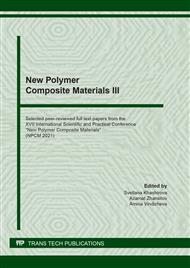[1]
How does FFF (FDM) 3d printer work? Available at: https://3ddaily.ru/technology/3dprinter-components-part1.html (accessed 01.04.2021).
Google Scholar
[2]
3D printer temperature is an essential setting for success. Read on for the best 3D printer temperatures for PLA, ABS, PETG, Nylon, and TPU. Available at: https://all3dp.com/2/the-best-printing-temperature-for-different-filaments/ (accessed 01.04.2021).
Google Scholar
[3]
I. S. Nefelov, M. I. Timchenko, N. I. Baurova, V. A. Zorin. Investigation of the influence of technological modes of 3D-printing on the strength parameters of parts. Mehanizatsiia stroitelstva. 2018. V. 79. No. 2. Pp. 25-30.
Google Scholar
[4]
3D Printing settings impacting part strength. Available at: https://markforged.com/resources/ learn/design-for-additive-manufacturing-plastics- composites/understanding-3d-printing-strength/ 3d-printing-settings-impacting-part-strength (accessed 01.04.2021).
DOI: 10.1089/3dp.2021.0247
Google Scholar
[5]
Experimental evaluation of the influence of 3d-printing parameters on the product strength E. A. Nosko, I.V. Odinokova, A.Yu. Chekanov. Journal of Advanced Research in Technical Science 2018. No. 9-1. Pp. 35-46.
Google Scholar
[6]
V.M. Petrov, S. N. Bezpal'chuk, S.P. Yakovlev. 3D-printing from plastics: inner structure influence on the strength, Vestnik Gosudarstvennogo universiteta morskogo i rechnogo flota imeni admirala S. O. Makarova 9.4 (2017): 765–776.
DOI: 10.21821/2309-5180-2017-9-4-765-776
Google Scholar
[7]
PETG combines ABS's strength with PLA's ease of printing. Learn the best PETG print settings, including print speed and retraction settings. Available at: https://all3dp.com/2/petg-print-settings-how-to-find-the-best-settings-for-petg/ (accessed 01.04.2021).
DOI: 10.46519/ij3dptdi.1148923
Google Scholar
[8]
Artillery Genius - New in 2020. Quiet and beautiful 3D printer. Available at: https://3dtoday.ru/blogs/3dsn-ru/artillery-genius (accessed 01.04.2021).
Google Scholar
[9]
ISO 527-2, Plastics - Determination of tensile properties - Part 2: Test conditions for moulding and extrusion plastics. 2nd Edition, February 15, (2012).
DOI: 10.3403/00921383u
Google Scholar
[10]
Ultimaker Cura. Available at: https://ultimaker.com/software/ultimaker-cura (accessed 01.04.2021).
Google Scholar


